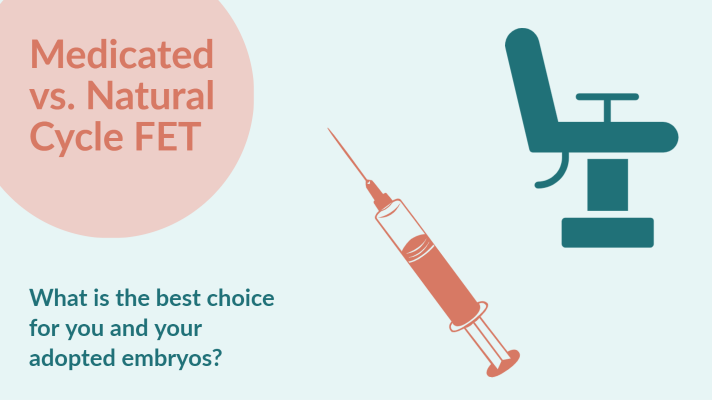It is an exciting thought that you can carry your adopted child through embryo adoption! However, there is a medical side of this adoption process that requires some thought. One decision families are faced with is whether to do a medicated (sometimes referred to as hormone replacement) cycle or a natural cycle when preparing for their frozen embryo transfer (FET). There is a lot to consider when weighing these two options.
To begin, remember the goal in preparing for your FET—it is to maximize your chances of pregnancy and delivery of your baby. The idea, broadly, is to mimic the natural environment of the uterus where conception is most likely to occur. The partnership you develop with your doctor and fertility clinic is going to be instrumental in navigating your decisions.
Medicated (Hormone Replacement) Cycle
The protocol here typically uses a combination of estrogen and progesterone to ensure that the endometrium (lining of the uterus) is ideally prepared to receive the thawed embryo. This can be delivered in a variety of ways. A recent study indicated that many women prefer the transdermal patch for estrogen. Most physicians prefer the endometrium to be 8-14.5mm thick when performing a FET. Remember that this protocol will vary based on each unique woman, be sure to talk to your doctor about your options.
Natural Cycle
This protocol depends on a woman’s body, the predictability of her cycles, and her ability to monitor her cycle. A natural cycle typically does not use any kind of estrogen replacements and may or may not use progesterone.
Another hurdle is to determine with your doctor which method is best for you, your embryos, and your unique body. Also, it is important to know that some doctors will not do a natural cycle oftentimes because the predictability rate of a successful outcome is not as researched or known.
Here are some Pros and Cons for each method to be considered:
| Medicated Cycle for FET | Natural Cycle for FET |
| PROS | PROS |
| Timing for the FET is set with much greater precision than a natural cycle | Less Hormonal Medications |
| There are fewer monitor appointments | Lower Cost |
| Predictable and Reliable | Larger patient participation and compliance |
| CONS | CONS |
| More hormone treatment | Your doctor may not be available for the FET |
| Cost for medications | More monitoring appointments |
| Your FET could be canceled because your LH surge could not be accurately measured |
Remember, this decision needs to be a cooperative one between you and your physician. It is important that you are all on the same page for your pregnancy success! Another important aspect of the FET is a discussion and agreement with your physician regarding how many embryos you will transfer in that particular cycle.
Regardless of the method you choose, here are some things to do after your FET:
- Pamper yourself!
- Eat a healthy diet
- Keep your stress levels low
- Limit caffeine
- Nosh on some pineapple! (This is a bit of a wives’ tale and there are no research studies that indicate that there is a correlation between eating pineapple and a successful FET…but if you like pineapple, go for it!)
To learn more about embryo adoption and if it is the right option to grow your family, visit EmbryoAdoption.org.


Recent Comments